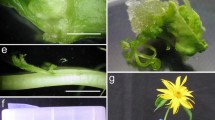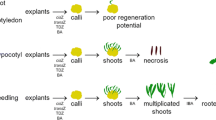Summary
All parts of leafy spurge seedlings can be regenerated when isolated and placed onto B5 medium. One-centimeter isolated hypocotyl segments were tested successfully for their usefulness as a bioassay system by comparing the response of auxins, herbicides, and cytokinins. Indole-3-acetic acid (IAA) was the most effective auxin to stimulate root formation. IAA was effective whether the hypocotyl segments remained on the same medium up to 60 days, or the segments were transferred to basal media after 2 or 5 days (pulse treatment). Pulse treatments with the other auxins resulted in stimulation of root formation; continuous or 5-day pulses of higher concentrations of indole-3-butyric acid,α-naphthaleneacetic acid and especially 2,4-dichlorophenoxyacetic acid and picloram formed excessive callus instead of roots. Picloram did not stimulate root formation, whether the treatment was continuous or pulse-treated. No roots formed with continuous picloram at 0.1 mg/liter or greater, but transfer to basal media did result in root and shoot formation at about 50% of the number formed on the controls. Lesser picloram concentrations had no effect. Shoots formed readily on untreated (control) segments, but continuous treatment with all three cytokinins, kinetin, zeatin, and zeatin riboside, increased the numbers of shoots about equally. Root formation was inhibited by the cytokinins at the higher concentrations (0.1 to 0.2 mg/liter). With the exception of a 5-day pulse of 0.04 mg/liter IAA, the auxins did not stimulate shoot formation, but generally inhibited shoot formation, even in pulse-treated cultures.
Similar content being viewed by others
References
Andreae, W. A. Uptake and metabolism of indoleacetic acid, naphthaleneacetic acid, and 2,4-dichlorophenoxyacetic acid by pea root segments in relation to growth inhibition during and after auxin application. Can. J. Bot. 45:737–753; 1967.
Ashton, F. M.; Crafts, A. S. Mode of action of herbicides, 2nd ed. New York: John Wiley & Sons; 1981.
Beasley, C. A. Anatomy and bud formation of subterranean parts of leafy spurge (Euphorbia esula L.). Brookings: South Dakota State Univ. 1964; Thesis.
Bandurski, R. S.; Schulze, A.; Domagalski, W., et al. Synthesis and metabolism of conjugates of indole-3-acetic acid. In: Schreiber, K.; Schutte, H. R.; Sembdner, G., eds. Conjugated plant hormones—structure, metabolism and function. Berlin: Deutscher Verlag der Wissenschaften; 1987:11–20.
Cohen, J. D.; Bandurski, R. S. Chemistry and physiology of the bound auxins. Annu. Rev. Plant Physiol. 33:403–430; 1982.
Collins, G. B.; Vian, W. E.; Phillips, G. C. Use of 4-amino-3,5,6-trichloropicolinic acid as an auxin source in plant tissue cultures. Crop Sci. 18:286–288; 1978.
Davidonis, G. H.; Hamilton, R. H.; Mumma, R. O. Comparative metabolism of 2,4-D in cotyledon and leaf callus from two varieties of soybeanGlycine-max. Plant Physiol. 65:94–97; 1980.
Davis, D. G.; Olson, P. A. Organogenesis in cell suspensions and hypocotyl segments of accessions of leafy spurge (Euphorbiacea). 14 Int. Botanical Congress, Berlin, Germany. Berlin-Dahlem: Botanical Museum; 1987; abstract 2-102c-4.
Davis, D. G.; Olson, P. A.; Stolzenberg, R. L. Organogenesis in cell cultures of leafy spurge (Euphorbiaceae) accessions from Europe and North America. Plant Cell Rep. 7:253–256; 1988.
Davis, D. G.; Wergin, W. P.; Dusbabek, K. E. Effects of organic solvents on growth and ultrastructure of plant cell suspensions. Pestic. Biochem. Physiol. 8:84–97; 1978.
Epstein, E.; Lavee, S. Conversion of indole-3-butyric acid to indole-3-acetic acid by cuttings of grapevine (Vitis vinifera) and olive (Olea europea). Plant Cell Physiol. 25:697–703; 1984.
Epstein, E.; Nissen, S. J.; Sutter, E. G. Indole-3-acetic acid and indole-3-butyric acid in tissues of carrot inoculated withAgrobacterium rhizogenes. J. Plant Growth Regul. 10:97–100; 1991.
Evenson, K. J.; Galitz, D. S.; Davis, D. G. The relationship of nitrogen source andin vivo nitrate reductase activity to root formation inEuphorbia esula cell suspension cultures. Plant Cell Rep. 7:361–364; 1988.
Gamborg, O. L.; Davis, B. P.; Stahlhut, R. W. Somatic embryogenesis in cell cultures ofGlycine species. Plant Cell Rep. 2:209–212; 1983.
Gamborg, O. L.; Miller, R. A.; Ojima, K. Nutrient requirements of suspension cultures of soybean root cells. Exp. Cell Res. 50:148–151; 1968.
Goren, R.; Bukovac, M. J. Mechanism of naphthaleneacetic acid conjugation. No effect of ethylene. Plant Physiol. 51:907–913; 1973.
Hamaker, J. W.; Johnston, H.; Martin, R. T., et al. A picolinic acid derivative: a plant growth regulator. Science 141:363; 1963.
Hangarter, R. P.; Good, N. E. Evidence that IAA conjugates are slow-release sources of free IAA in plant tissue. Plant Physiol. 68:1424–1427; 1981.
Huang, L-C.; Chi, D-L. Pivotal roles of picloram and gelrite in banana callus culture. Environ. Exp. Bot. 28:249–258; 1988.
Kartha, K. K.; Gamborg, O. L.; Constabel, F., et al. Regeneration of cassava plants from apical meristems. Plant Sci. Lett. 2:107–113; 1974.
Kefford, N. P.; Caso, O. H. A potent auxin with unique chemical structure—4-amino-3,5,6-trichloropicolinic acid. Bot. Gaz. 127:159–163; 1966.
Lym, R. G.; Messersmith, C. G. Cost-effective long term leafy spurge (Euphorbia esula) control with herbicides. Weed Technol. 4:635–641; 1990.
Nissen, S. J.; Foley, M. E. Correlative inhibition and dormancy in root buds of leafy spurge (Euphorbia esula). Weed Sci. 35:155–159; 1987.
Smulders, M. J. M.; Van De Ven, E. T. W. M.; Croes, A. F., et al. Metabolism of 1-naphthaleneacetic acid in explants of tobacco: evidence for release of free hormone from conjugates. J. Plant Growth Regul. 9:27–34; 1990.
Watson, A. K., editor. Leafy spurge, Monograph series number 3. Champaign, IL: Weed Science Society of America; 1985.
Author information
Authors and Affiliations
Rights and permissions
About this article
Cite this article
Davis, D.G., Olson, P.A. Organogenesis in leafy spurge (Euphorbia esula L.). In Vitro Cell Dev Biol - Plant 29, 97–101 (1993). https://doi.org/10.1007/BF02632278
Received:
Accepted:
Issue Date:
DOI: https://doi.org/10.1007/BF02632278




